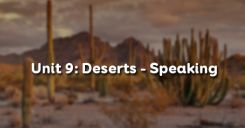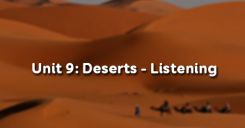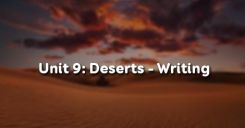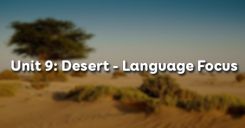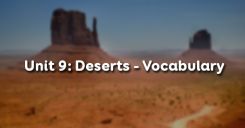Bài học Unit 9 Deserts phần Reading truyền tải thông tin về sa mạc và cuộc sống thiên nhiên ở đây. Qua đó, luyện tập cho các em đoán nghĩa theo ngữ cảnh và gợi ý để làm bài tập chọn đúng hay sai.
Tóm tắt bài
1. Before You Read Unit 9 Lớp 12
Work in pairs. Ask and answer the following questions.
(Làm việc theo cặp. Hỏi và trả lời những câu hỏi sau)
1. What do you know about deserts? (Em biết gì về sa mạc?)
2. What kinds of plants and animals live in a desert? (Loại động thực vật nào sống ở sa mạc?)
3. Name some of the countries which have deserts. (Kể tên một vài nước có sa mạc)
Guide to answer
1. Deserts are the large areas of sand without tree and water, but with severe climates, very hot during the day, and very cold at night. There is very little rainfall here; very few people and animals live except for in oases.
2. In a desert, only cacti and a kind of spinifex can grow. No kind of animals can live in deserts.
3. Australia, Mongolia, the USA. and in north Africa have deserts.
2. While You Read Unit 9 Lớp 12
Read the passage and do the tasks that follow. (Đọc đoạn văn và làm bài tập bên dưới)
2.1. Unit 9 Reading Task 1
Give the Vietnamese equivalents to the following words or phrases.
(Hãy cho nghĩa tiếng Việt tương đương với những từ hoặc cụm từ sau.)
1. stretch _________ 6. dune ___________
2. sandy _________ 7. sloping ____________
3. aerial survey _______ 8. steep _____________
4. Royal Geograhical Society of Australia __________ 9. hummock _________
5. Australian Aborigine __________ 10. crest ____________
11. spinifex ____________
Guide to answer
1. stretch (v): trải dài; (n): dải đất
2. sandy (adj): có cát
3. aerial survey (n): cuộc khảo sát trên không
4. Royal Geograhical Society of Australia : Hội Địa lí Hoàng gia Úc
5. Australian Aborigine (n): thổ dân Úc, dân bản xứ Úc
6. Dune (n): đồi cát
7. Sloping (n): dốc thoai thoải
8. Steep (n): dốc đứng
9. Hummock (n): gò, đống
10. Crest (n): đỉnh
11. Spinifex (n): cỏ lá nhọn (ở sa mạc Úc)
2.2. Unit 9 Reading Task 2
Decide whether the statements are true (T) or false (F).
(Xác định các câu sau đúng hay sai)
1. According to the passage, there are three great deserts in Australia. (Theo như bài đọc, Úc có 3 sa mạc lớn.)
2. The Simpson Desert is the largest one in Australia. (Sa mạc Simpson là sa mạc lớn nhất nước Úc.)
3. The desert was named after Simpson in 1929. (Sa mạc ấy được đặt theo tên ông Simpson năm 1929.)
4. Colson and Madigan travelled across the Simpson Desert in 1936. (Colson và Madigan đã du hành xuyên sa mạc Simpson vào năm 1936.)
5. There are more dunes in the western part of the desert. (Khu vực phía tây của sa mạc có nhiều đụn cát hơn.)
6. Dry salt lakes are in the northern part of the desert. (Các hồ nước mặn khô cạn nằm ở khu vực phía bắc của sa mạc.)
Guide to answer
1. According to the passage, there are three great deserts in Australia. (F) ---> Three great streches of sandy desert almost circle the centre of Australia.
2. The Simpson Desert is the largest one in Australia. (F) ---> No information about this.
3. The desert was named after Simpson in 1929. (T)
4. Colson and Madigan travelled across the Simpson Desert in 1936. (F) ---> Colson and an Australian Aborigine took camels across the desert in 1936.
5. There are more dunes in the western part of the desert. (F) ---> In the western part of desert, there is a network of short dunes.
6. Dry salt lakes are in the northern part of the desert. (T)
2.3. Unit 9 Reading Task 3
Answer the following questions.
(Trả lời những câu hỏi bên dưới)
1. What are the names of the three great stretches of sandy desert which circle the centre of Australia? ((Tên của ba miền sa mạc lớn xung quanh nước Úc là gì?)
2. Where is the Simpson Desert? (Sa mạc Simpson nằm ở đâu?)
3. When did the first European enter the desert? (Người châu Âu đầu tiên đi vào sa mạc là khi nào?)
4. Who was Simpson? (Simpson là ai?)
5. How did E. A. Colson and an Australian Aborigine travel across the desert? (E. A. Colson và thổ dân Úc du hành băng qua sa mạc bằng cách nào?)
6. What are the dunes like in the western and northern parts of the desert? (Những đụn cát ở phía tây và phía bắc của sa mạc trông như thế nào?)
7. How many kinds of grass grow in the Simpson Desert? What are they? (Có bao nhiêu loại cỏ mọc trong sa mạc Simpson? Đó là những loại nào?)
Guide to answer
1. They are Great Victoria, Gibbon, Great Sandy, Tanami Deserts and Simpson Desert
2. It lies between Late Eyre in the south, the Macdonnel Ranges in the north, the Mulligan and the Diamantia Rivers in the east, and the Macumba and Finke Rivers in the west.
3. In 1845.
4. He was the President of the South Australian Branch of the Royal Geographical Society of Australia.
5. They took camels across the desert.
6. In the western part, they are short, mostly less than 10 meters high, and in the northern part, they are paralell and up to 20 meters high.
7. Two. They are hummock grasses and spinifex.
3. After You Read Unit 9 Lớp 12
Read this story and answer the questions that follow.
(Đọc câu chuyện sau rồi trả lời các câu hỏi bên dưới.)
1. Is the story funny? (Đây có phải là câu chuyện cười không?)
2. Where is the fun? (Yếu tố cười chỗ nào?)
Phần dịch câu chuyện
Ở một nhà hàng, một thông dịch viên người Việt đang dùng cơm tối với một thương gia Mĩ. Bữa ăn tối ngon và cả hai rất thích thú. Trước khi bữa ăn kết thúc, người thông dịch hỏi thương gia Mĩ, "ông muốn gì cho sa mạc của ông?” Sau khi suy nghĩ một tí, thương gia Mĩ trả lời. "Cây và nước.”
Guide to answer
1. Yes, it really is.
2. It’s the interpreter's pronunciation. He pronounced the word “dessert" wrongly, which made the American businesman misunderstand him. That's really a great pity or shame.
Giải thích
Trong tiếng Anh, desert vừa là động từ vừa là danh từ. Động từ desert có trọng âm rơi vào âm tiết thứ 2 và có nghĩa là từ bỏ. Danh từ có trọng âm rơi vào âm tiết thứ nhất nghĩa là sa mạc. Trong tình huống này từ dessert có cách phát âm giống động từ desert và có nghĩa là món tráng miệng. Yếu tố gây cười trong trường hợp này là cách phát âm sai của người phiên dịch.
4. Phần dịch Reading Unit 9 Lớp 12
Ba miền sa mạc lớn gần như vây quanh miền trung nước Úc. Phía bắc đồng bằng Nullabor là sa mạc Great Victoria. Ở phía tây, sa mạc Gibbon, Great Sandy và Tanami tạo thành một vùng cát mênh mông. Phía bắc hồ Eyre là sa mạc Simpson, vùng đất cuối cùng ở Úc được khám phá.
Sa mạc Simpson nằm giữa hồ Eyre ở phía nam, rặng Macdonnell ở phía bắc, sông Diamantina và Mulligan ở phía đông, sông Macumba và Finke ở phía tây. Vào năm 1845, người châu Âu đầu tiên đặt chân vào sa mạc Simpson. Dù vậy, sa mạc này vẫn còn là một bí ẩn cho đến khi Madigan thực hiện một cuộc trắc lượng trên không vào năm 1929. Ông đã đặt tên sa mạc là Simpson. theo tên của Chủ tịch chi nhánh miền nam của Hội Địa lý Hoàng gia Úc.
Năm 1936, Colson và một thổ dân Úc cưỡi lạc đà băng qua sa mạc. Họ du hành dọc theo ranh giới giữa miền nam nước Úc và hạt Bắc. Ba năm sau, Madigan tiến hành một cuộc thám hiểm khoa học băng qua các đụn cát theo một lộ trình lệch về phía bắc. Cả Colson lẫn Madigan đều đi về hướng đông băng qua sa mạc Simpson.
Trong sa mạc Simpson có rất nhiều dạng đụn cát. Ở khu vực phía tây sa mạc là mạng lưới đụn cát thấp, phần lớn thấp dưới 10 mét. Cỏ đụn cát mọc ở phần cát xốp trên đỉnh, còn cỏ lá nhọn mọc ở hành lang giữa các đụn cát và trên những sườn vững chãi hơn.
Ở phía bắc sa mạc, các đụn cát song song nhau và được chia cách bởi các hành lang đất cây bụi thấp và trống trải. Cỏ lá nhọn mọc trên sườn đụn cát. Các đụn cát ở đây có màu nâu đỏ thẫm, những ở khu vực giữa Queenland, Nam Úc và hạt Bắc thì cát có màu nhạt hơn. Các hồ nước mặn khô cạn dài đến 70 kilomet và rộng đến 15 kilomet nawmg giữa những đụn cát cao đến 20 mét.
Bài tập minh họa
Read the passage carefully and choose the correct answer.
A desert is a hostile, potentially deadly environment for unprepared humans. In hot deserts, high temperatures cause rapid loss of water due to sweating, and the absence of water sources with which to replenish it can result in dehydration and death within a few days. In addition, unprotected humans are also at risk from heatstroke.
Humans may also have to adapt to sandstorms in some deserts, not just in their adverse effects on respiratory systems and eyes, but also in their potentially harmful effects on equipment such as filters, vehicles and communication equipment. Sandstorms can last for hours, sometimes even days.
Despite this, some cultures have made hot deserts 'their home for thousands of years, including the Bedouin, Tuareg tribe, and Pueblo people. Modern technology, including advanced irrigation systems, desalinization and air conditioning, has made deserts much more hospitable. In the United States and Israel for example, desert farming has found extensive use.
In cold deserts, hypothermia and frostbite are the chief hazards, as well as dehydration in the absence of a source of heat to melt ice for drinking. Falling through pack-ice or surface ice layers into freezing water is a particular danger requiring emergency action to prevent rapid hypothermia. Starvation is also a hazard; in low temperatures the body requires much more food energy to maintain body heat and to move. As with hot deserts, some people such as the Inuit have adapted to the harsh conditions of cold deserts.
1.The text is about ________.
a. troubles that human beings have to face in a desert
b. desert storms and desert inhabitants
c. hot deserts and cold deserts in the United States
d. desert hospitality and environment
2. Which is not a problem for an unprepared man in a hot desert?
a. sandstorm b. loss of water c. irrigation d. heatstroke
3. Sandstorms ________.
a. do no harm to machinery
b. have effects only on the eyes
c. never lasts more than one hour
d. have bad effects on both human beings and machinery
4. Which sentence is true?
a. No one can survive in both hot and cold deserts.
b. Modern technology makes deserts more hospitable.
c. In the United States, all deserts are quite uninhabited.
d. There are no deserts in Israel.
5. Which is not a problem in cold deserts?
a. Starvation b. Hypothermia c. Frostbite d. Body heat
Key
| 1 | 2 | 3 | 4 | 5 |
| A | C | D | B | D |
Answer the questions
- What is the desert?
- How is the life in hot and cold deserts?
Key
- A desert is a hostile, potentially deadly environment for unprepared humans.
- In hot deserts, high temperatures cause rapid loss of water due to sweating, and the absence of water sources with which to replenish it can result in dehydration and death within a few days. And in cold deserts, hypothermia and frostbite are the chief hazards, as well as dehydration in the absence of a source of heat to melt ice for drinking.
Bài tập trắc nghiệm Reading Unit 9 Lớp 12
Như vậy là các em đã xem qua bài giảng phần Reading Unit 9 Deserts chương trình Tiếng Anh lớp 12 về sa mạc. Để củng cố và mở rộng kiến thức đọc hiểu mời các em tham gia Trắc nghiệm Unit 9 lớp 12 Reading
-
Câu 1:
(1) _________
- A. coldest
- B. hottest
- C. driest
- D. wettest
-
Câu 2:
(2) _________
- A. rain
- B. rainfall
- C. raindrop
- D. raincoat
-
Câu 3:
(3) _________
- A. with
- B. for
- C. about
- D. in
Câu 4-10: Mời các em đăng nhập xem tiếp nội dung và thi thử Online để củng cố kiến thức về bài học này nhé!
Hỏi đáp Reading Unit 9 Lớp 12
Trong quá trình học tập nếu có thắc mắc hay cần trợ giúp gì thì các em hãy comment ở mục Hỏi đáp, Cộng đồng Tiếng Anh HOC247 sẽ hỗ trợ cho các em một cách nhanh chóng! Sau bài học Reading này các em chuyển qua bài học mới Unit 9 Deserts - Speaking kế tiếp. Chúc các em học tốt!
-- Mod Tiếng Anh 12 HỌC247





